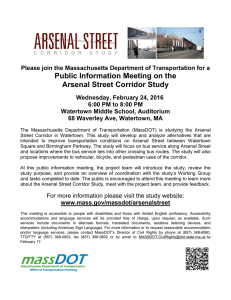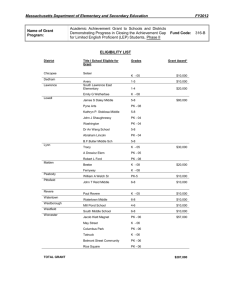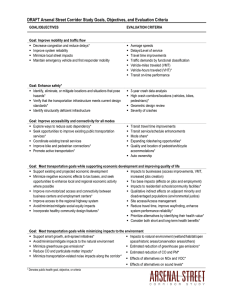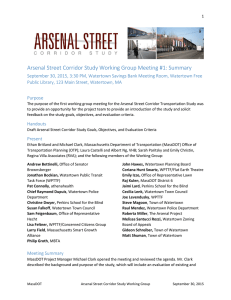Arsenal Street Corridor Study - Public Meeting #1: Summary
advertisement
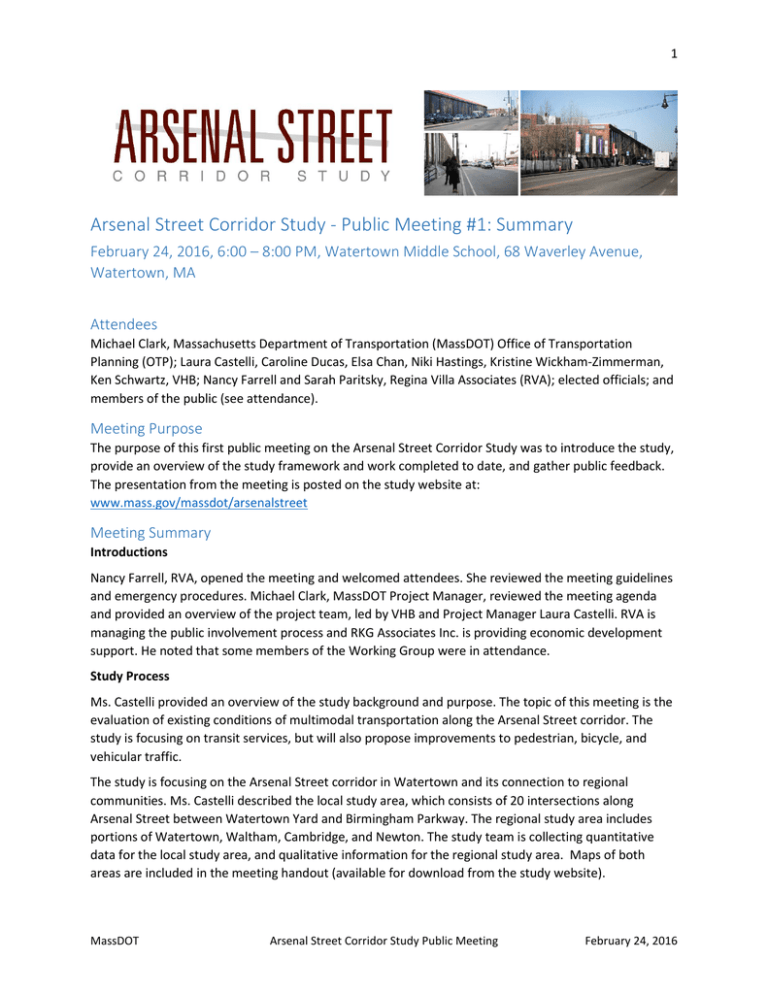
1 Arsenal Street Corridor Study - Public Meeting #1: Summary February 24, 2016, 6:00 – 8:00 PM, Watertown Middle School, 68 Waverley Avenue, Watertown, MA Attendees Michael Clark, Massachusetts Department of Transportation (MassDOT) Office of Transportation Planning (OTP); Laura Castelli, Caroline Ducas, Elsa Chan, Niki Hastings, Kristine Wickham-Zimmerman, Ken Schwartz, VHB; Nancy Farrell and Sarah Paritsky, Regina Villa Associates (RVA); elected officials; and members of the public (see attendance). Meeting Purpose The purpose of this first public meeting on the Arsenal Street Corridor Study was to introduce the study, provide an overview of the study framework and work completed to date, and gather public feedback. The presentation from the meeting is posted on the study website at: www.mass.gov/massdot/arsenalstreet Meeting Summary Introductions Nancy Farrell, RVA, opened the meeting and welcomed attendees. She reviewed the meeting guidelines and emergency procedures. Michael Clark, MassDOT Project Manager, reviewed the meeting agenda and provided an overview of the project team, led by VHB and Project Manager Laura Castelli. RVA is managing the public involvement process and RKG Associates Inc. is providing economic development support. He noted that some members of the Working Group were in attendance. Study Process Ms. Castelli provided an overview of the study background and purpose. The topic of this meeting is the evaluation of existing conditions of multimodal transportation along the Arsenal Street corridor. The study is focusing on transit services, but will also propose improvements to pedestrian, bicycle, and vehicular traffic. The study is focusing on the Arsenal Street corridor in Watertown and its connection to regional communities. Ms. Castelli described the local study area, which consists of 20 intersections along Arsenal Street between Watertown Yard and Birmingham Parkway. The regional study area includes portions of Watertown, Waltham, Cambridge, and Newton. The study team is collecting quantitative data for the local study area, and qualitative information for the regional study area. Maps of both areas are included in the meeting handout (available for download from the study website). MassDOT Arsenal Street Corridor Study Public Meeting February 24, 2016 2 Ms. Castelli explained that the study is currently in the issues evaluation phase. She noted the Public Involvement Plan, from the study’s framework phase, is a living document and will be continuously updated. The study began in September 2015 and will continue through March 2017. Comments are welcome throughout the process, but there will be a 30-day comment period on the final report at the end of the study. Goals, Objectives, & Evaluation Criteria Ms. Castelli reviewed the study goals and referred attendees to the handout for the complete set of objectives and evaluation criteria. Woven throughout the study goals are a number of public health elements. Public Involvement Ms. Castelli said the study includes numerous opportunities for public involvement, including six Working Group meetings and three public meetings. A project website includes a link to sign up for email updates. Ms. Castelli described the role and members of the Working Group, who include representatives from state and local agencies, elected officials, businesses, Perkins School for the Blind, and several civic and community organizations. Existing Conditions Evaluation Ms. Castelli said the town of Watertown has approximately 5,710 residents, 2,740 households, and 6,630 jobs. The corridor includes some residential parcels, a large number of industrial parcels, and many proposed residential developments. The employment in Watertown is shifting from industrial to commercial and office sectors. Residents and employees of Watertown primarily use a personal vehicle to commute to work; very few walk or ride a bicycle. Ms. Castelli introduced Caroline Ducas, VHB, to describe the existing transit characteristics and infrastructure. Ms. Ducas highlighted the MBTA bus routes 70 and 70A, which travel through the corridor and connect with many MBTA bus routes at Watertown Square and Watertown Yard. Ms. Ducas said the schedules and frequency of service offered on the 70 and 70A indicate that most riders check the schedule before leaving for the bus. Ms. Ducas summarized the condition of bus stops in the corridor. Most consist of posted signs only, but covered shelters are provided at the Watertown and Arsenal Mall stops. There are frequently narrow sidewalks and utility boxes and other obstacles in the sidewalks near the bus stops, which create accessibility problems. The busiest areas for boardings (when passengers get on the bus) and alightings (when passengers get off the bus) occur at the western and eastern ends of the corridor. Ms. Ducas explained that passenger loading indicates how crowded the bus is, and is based on MBTA’s current Service Delivery Policy. The MBTA defines the maximum average acceptable load as 54 passengers during peak periods, which means all seats are taken and some passengers are standing in the aisle. The maximum average acceptable load is 39 passengers, indicating the seated capacity is at 100 percent. Ms. Ducas noted Routes 70 and 70A fail the current MBTA loading standards during the early morning (inbound direction) time period. Route 70 also fails during midday school (inbound), evening (inbound and outbound), and night/sunrise (inbound) periods. Ms. Ducas described the transit vehicle load maps for the corridor at different times of day. Key considerations for next steps include a closer look at passenger loading data, schedule adherence, MassDOT Arsenal Street Corridor Study Working Group February 24, 2016 3 passenger hours of delay, and travel time variability, all of which assess how reliable the bus routes are currently. Ms. Castelli noted that the MBTA’s Service Delivery Policy will be changing soon, and the MBTA will host public meetings on that topic. Ms. Castelli stated that the existing conditions will set the baseline for the alternatives comparison and analysis. The study team has collected daily traffic volume counts during morning and afternoon peak periods. Ms. Castelli described maps showing multimodal demands and “person trips” at key locations. About 85 percent of users are in cars and 14 percent are on the bus. The buses make up less than one percent of vehicles traveling along the corridor, indicating that more bus ridership would allow more people to pass through the corridor. The study team looked at the condition of traffic signals at each intersection along the corridor. Any issues with the signals can be included in the study’s short-term improvements list and the Town may try to fix these issues soon. One issue was already resolved at Watertown Square. Ms. Castelli described the intersections of Galen Street at Watertown Street/Nonantum Road and Watertown Square. On average, queues at one intersection cause backups at the other. A signal issue at Arsenal Street was also fixed. The study team reviewed crash data from MassDOT’s list of top 200 crash locations, the Highway Safety Improvement Program (HSIP) funding eligibility, and MassDOT’s Crash Database maintained by the Registry for Motor Vehicles (RMV). Ms. Castelli explained that the bulk of crashes are not caused by geometry, but rather driver impatience at unsignalized intersections. Ms. Castelli identified some intersections that are the highest priority from a safety perspective, including Watertown Square. Ms. Castelli described the condition of pedestrian accommodations in the corridor. While there are sidewalks on both sides of Arsenal Street, width is an issue on the outbound side, especially for people with disabilities. The study team conducted an inventory of curb ramps for their compliance with the Americans with Disabilities Act (ADA). Some ramps could be upgraded at a relatively low cost. The close vicinity of Perkins School for the Blind, a member of the Working Group, reinforces the need for safe, accessible sidewalks. Ms. Castelli said there is a fairly good network of bicycle accommodations along the Charles River, with some plans for extensions. Ms. Castelli noted that there are limited environmental resources in the study area that are not expected to affect the development of alternatives. However, each alternative will be evaluated for its impacts to natural and historical/cultural resources and hazardous materials. Ms. Castelli described the study’s public health assessment, which Ken Schwartz of VHB, is available to discuss further after the presentation. She said the rates of obesity and inactive living are rising faster in Watertown than in the rest of the state. Ms. Castelli reviewed the primary public health contributors, including access to public transit and pedestrian and bicycle facilities, and primary public health barriers, including bus services at or over capacity and insufficient pedestrian safety features. Next Steps Looking ahead, Ms. Castelli said the study team will develop the 2040 future conditions and identify issues, opportunities, and constraints before it develops and analyzes alternatives. The third Working Group meeting will be scheduled in early spring and the second public meeting will be held in summer 2016. MassDOT Arsenal Street Corridor Study Working Group February 24, 2016 4 Question & Answer Session Ms. Farrell said the study team is taking notes and will post the presentation and summary to the website after the meeting. She opened the floor to questions from elected officials. Aaron Dushku, Watertown Town Council, thanked MassDOT for initiating this study. He is interested in changes to the MBTA bus routes 70 and 70A, based on a Cambridge Transportation Management Association (TMA) blogger’s proposal. Ms. Castelli said she is aware of this idea and understands it has morphed into a parallel project. She will coordinate with the MBTA in the spring about it. Philip Groth, MBTA Service Planner, said the MBTA is considering a split between routes 70 and 70A. He added that major service changes like this are typically only approved during a Service Plan update. Councilor Dushku commented that the new commuter rail station at Boston Landing in Brighton is not currently directly linked to bus routes. Mr. Groth said the MBTA is looking into this and sees the value in a direct connection. Ms. Farrell opened the floor to questions and comments from all attendees. Joe Levendusky, Watertown Public Transit Task Force (WPTTF), expressed his concern about the sustainability of the levels of car versus transit usage. He said the low transit user numbers are a testament to the poor service of MBTA buses. He suggested that the study conduct a survey of households asking what it would take to get drivers out of their cars and onto public transit. Mr. Levendusky noted that the loading numbers are skewed since one packed bus may be followed by an empty bus, which affects the average. He personally avoids taking the 70 bus due to its poor service. Mr. Clark thanked Mr. Levendusky for his comments and suggestions, and said MassDOT would also like to encourage the use of public transit. This is consistent with statewide goals in increasing mode share and decreasing greenhouse gases. Ms. Castelli added that the data speaks to the current Service Delivery Policy and alternatives will speak to the study’s goals and objectives, GreenDOT, and the Healthy Transportation Compact. Steve Owens asked how the limits of the regional study area were determined, and why Allston is not included. He noted the Boston Redevelopment Authority has plans for Allston, and Watertown is a destination for Allston residents. Ms. Castelli said the study team uses the regional study area to understand developments surrounding the corridor that will impact travel mode volumes. It could be expanded to include Allston. Maria Saiz, Watertown Bike/Ped Commission, said she was excited to learn about the study. She asked if MassDOT will consider growth in the corridor and the traffic and parking studies conducted by developers. Ms. Castelli confirmed the study team is taking developments into account and using the Central Transportation Planning Staff (CTPS) regional model for growth. These will be shared at the next public meeting. Ms. Saiz added that the corridor is bad for biking; since there is not enough room, many people ride their bikes on the sidewalk. It can be tedious to cross back and forth when there is not a bike path on the same side of the street near School Street. It is also uncomfortable to walk through the corridor due to sidewalk widths and obstacles. Ms. Saiz suggested that the corridor needs visual appeal and beauty. Ms. Castelli said she agrees and acknowledged the problems Ms. Saiz described. Ms. Castelli suggested that there may be partnership opportunities between athenahealth, Boylston Properties, and the Town to improve the bike amenities. Ms. Castelli added that aesthetics can also be tied to the public health assessment. MassDOT Arsenal Street Corridor Study Working Group February 24, 2016 5 A participant said that Somerville is implementing 12-foot wide sidewalks and asked if this is possible on Arsenal Street. Ms. Castelli said this would tie in with MassDOT’s Complete Streets policy. The study team will consider whether expanding the sidewalk within a limited right-of-way is possible. Vincent Piccirilli, a member of Watertown Town Council reported that athenahealth is applying for a grant to improve infrastructure on Arsenal Street, Beacon Street, and Greenough Boulevard. The Town Council is studying the idea of burying the power lines with other funding (approximately $15 to $18 million over five to 10 years), to help improve the pedestrian experience. Ms. Castelli noted that athenahealth has offered to share data with the study team. Rachael Sack said she lives on Frank Street, parallel to Arsenal Street and North Beacon Street. She echoed earlier comments about complete streets and shared her concerns about speeding cars and buses on Arsenal Street. Ms. Sack said her neighborhood has families with young kids and Perkins School for the Blind. Drivers use Frank Street for access between Arsenal Street and North Beacon Street. Ms. Castelli said the width of the road affects speeds, which would lower if the road is narrowed. She said the study team will investigate traffic volumes on cut-through streets. It is difficult to discourage drivers from taking cut-through streets, but there are measures MassDOT can take to make it a less desirable option. Andre Compagne, Watertown Bike/Ped Commission, suggested the study team consider the connection to the Watertown/Cambridge Greenway once it is finished, as it will bring more bike cross-traffic. Ms. Castelli agreed the study team will take cross-traffic, and not just linear traffic, into consideration. Ilana Mainelli explained there is no place (kiosk or station) for her to add value to her Charlie Card in Watertown. When she adds value to her card on the bus, she realizes it holds up the entire bus. Ms. Mainelli added that she does not think the bus follows the schedule. She was later informed that she can add value to her Charlie Card online. Ms. Farrell thanked her for her comments. Mr. Dushku shared his ideas about alternative ways to pay fares, in addition to Charlie Cards. Using a cell phone to pay would make it easier and promote more ridership. Mr. Dushku supported the idea of 12foot wide sidewalks, a bus rapid transit lane, and bike path. He also suggested MassDOT consider using North Beacon Street for transit, since space on Arsenal Street is limited. Ms. Castelli said the study team will consider these ideas but cautioned that it would be difficult to accommodate each one of the requests participants had raised over the course of the meeting. As the study moves forward and alternatives are proposed, a discussion concerning prioritization of possible improvements within the available roadway right of way may be necessary. Kathy Martin said she lives in the Arsenal Park Condominiums, a 36-unit building with apartments that house elderly and infirm people. She said some of the residents in wheelchairs travel on the road because of the poor sidewalk condition. Ms. Martin said she rides her bike and avoids Arsenal Street at all costs because of safety concerns. Her husband was in a bicycle/car crash at Arsenal Street and Greenough Boulevard. Ms. Martin proposed the idea of a shared lane for buses and bikes only. She added that she walks instead of taking the 70 bus. Mr. Levendusky endorsed the idea of a shared lane on Arsenal Street for buses and bikes from the Charles River to Watertown Square. He suggested MassDOT consider a small physical barrier to separate the shared lane from the rest of traffic. He added that former General Manager Bev Scott said that MassDOT Arsenal Street Corridor Study Working Group February 24, 2016 6 Charlie Cards were a “money sink” for the MBTA. Mr. Levendusky said sometimes bus operators don’t collect cash fares because they do not want to wait and hold up the rest of the bus. Ms. Farrell thanked participants for attending and concluded the meeting. Attendance Connie Brown Gordon Brown William N. Brownsberger, Massachusetts Senate Bruce Coltin Andre Compagne, Watertown Bike/Ped Commission Bill Conroy, Boston Transportation Department Aaron Dushku, Watertown Town Council Susan Falkoff, Watertown Town Council Larry Field, Massachusetts Smart Growth Alliance (MSGA) Philip Groth, MBTA Service Planning Nancy Hammett Jonathan Hecht, Massachusetts House of Representatives Coriana Hunt Swartz, Watertown Public Transit Task Force (WPTTF) Janet Jameson Joe Levendusky, WPTTF Anna Mackay, Guerrilla Development Steven Magoon, Town of Watertown, Department of Community Development and Planning (DCDP) Ilana Mainelli Kathy Martin Steve Owens Anthony Palomba, Watertown Town Council Mark Peterson, WPTTF Vincent Piccirilli, Watertown Town Council Rachael Sack Maria Saiz, Watertown Bike/Ped Commission Melissa Santucci Rozzi, Watertown Zoning Board of Appeals Gideon Schreiber, Watertown DCDP Adam Sennott, Watertown Tab Matt Shuman, Town of Watertown, Department of Public Works Pat Sullivan, 128 Business Council Elodia Thomas MassDOT Arsenal Street Corridor Study Working Group February 24, 2016
